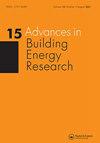Identifying salient features of cooling energy usage of commercial buildings using explainable artificial intelligence
IF 2.5
Q2 CONSTRUCTION & BUILDING TECHNOLOGY
引用次数: 0
Abstract
ABSTRACTElectrical energy usage of commercial buildings (over 60% in the USA) is of growing concern due to its impact on the environment. To reduce it, it is necessary to identify the factors contributing to commercial building energy usage. Towards this, we studied the importance of various building features and their contributions on cooling energy, using two datasets of Commercial Building Energy Consumption Survey (CBECS) 2018 and 2012. For this, Shapash, an explainable artificial intelligence technique, was used, with Random Forest, to predict the cooling energy usage intensity (EUI). The two most important features for 2018 are cooling degree days and principal building activity, while cooling degree days and cooling percentage were for 2012 with 54.79% and 33.46% contributions of the total consumption respectively. The comparison of feature importance indicated that cooling degree days are the topmost important feature impacting cooling EUI and have a more significant contribution of 34.29% for 2018 and 19.68% for 2012. Overall, the most important features impacting cooling EUI were cooling degree days, principle building activity, cooling percentage and total hours open per week. The results from this study provide insights into the most significant factors influencing energy consumption and help in developing strategies for reducing it.KEYWORDS: Explainable artificial intelligence (XAI)Shapashcooling energy usageenergy efficiencyrandom forestCBECSfeature importance Disclosure statementNo potential conflict of interest was reported by the author(s).利用可解释的人工智能识别商业建筑冷却能源使用的显著特征
摘要商业建筑的电能使用(在美国超过60%)因其对环境的影响而日益受到关注。为了降低能耗,有必要确定影响商业建筑能耗的因素。为此,我们使用2018年和2012年商业建筑能耗调查(CBECS)的两个数据集,研究了各种建筑特征的重要性及其对冷却能源的贡献。为此,使用可解释的人工智能技术Shapash与随机森林(Random Forest)一起预测冷却能源使用强度(EUI)。2018年最重要的两个特征是冷却度日数和主要建筑活动,而冷却度日数和冷却百分比分别占2012年总消费量的54.79%和33.46%。特征重要性比较表明,冷却度天数是影响冷却EUI的最重要特征,对2018年和2012年的贡献更为显著,分别为34.29%和19.68%。总体而言,影响冷却EUI的最重要特征是冷却度天数、主要建筑活动、冷却百分比和每周总开放时间。本研究的结果提供了对影响能源消耗的最重要因素的见解,并有助于制定减少能源消耗的策略。关键词:可解释人工智能(XAI) shapash冷却能源使用能效随机森林cbecs特征重要性披露声明作者未报告潜在利益冲突。
本文章由计算机程序翻译,如有差异,请以英文原文为准。
求助全文
约1分钟内获得全文
求助全文
来源期刊

Advances in Building Energy Research
CONSTRUCTION & BUILDING TECHNOLOGY-
CiteScore
4.80
自引率
5.00%
发文量
11
 求助内容:
求助内容: 应助结果提醒方式:
应助结果提醒方式:


